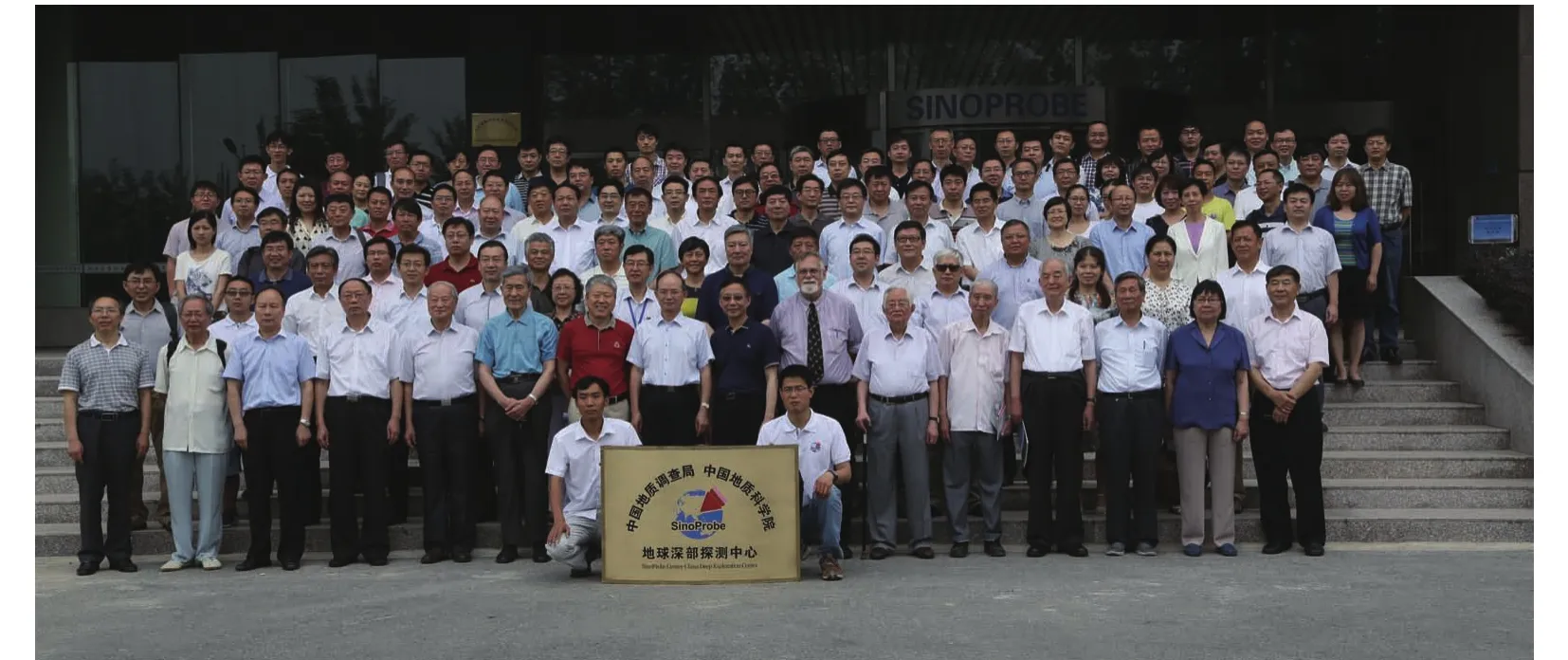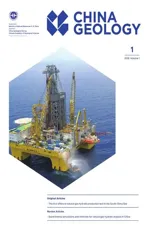Introduction of the SinoProbe Center, China Geological Survey
2018-01-18
The SinoProbe Center of the China Geological Survey is a geosciences innovation center for deep geological surveys and deep process researches, which is also the national base for deep exploration and deep earth science researches in China.The center is mainly focused on deep explorations of the earth, deep geological surveys and fundamental researches on deep earth science. The main missions of the SinoProbe Center are to undertake research programs on deep earth structural and compositional exploration, technology research and development on deep earth exploration, exploitation and evaluation of deep oil and gas, deep mineral resources, deep geothermal energy, and underground space exploration and utilization.

Group photo of the SinoProbe Center in Beijing, China
1. Organization and leading experts
Honorary directors: Ting-dong Li (member of CAS), Yuchuan Chen (member of CAS)
Director: Guang-sheng Yan (research professor)
Deputy directors: Qing-tian Lü (research professor), Yan Ma (research professor)
Leading scientists: Shu-wen Dong (research professor),Ri-xiang Zhu (member of CAS), Cheng-shan Wang (member of CAS), Rui Gao (member of CAS), Zeng-qian Hou (member of CAS), Zong-li Huang (research professor), Da Wang(Research Professor), De-wu Qiao (Research Professor).
2. Divisions of the SinoProbe Center
2.1 Division of crustal structure and deep energy exploration and evaluation
This division is based on geophysical technologies, multidisciplinary and multi-deep exploration scales to reveal the deep processes, 3D structures, and metallogenic processing of the typical metallogenic belts or ore-concentrated areas in the deep earth. The division is aimed to construct regional metallogenic dynamics, discover innovative technologies and methods of geophysical data collection, processing,develop multi-databased inversion and lithological recognition methods,and set up technical combined system of deep mineral deposits exploration.
2.2 Division of crustal structure and deep energy exploration and evaluation
This division is focused on deep and ultra-deep structure exploration of oil and gas potentials, evaluation of largescaled orogenic petroliferous basin belts, and new oil and gas strata discoveries in the North China basins to further explore deep oil and gas resources.
2.3 Division of underground space exploration and utilization
This division is aimed to carry out following technologies such as anti-interference high precision geophysical techniques, underground drilling and logging techniques with precise localization and monitoring techniques, multiple parameter information integration and AI modeling, collaborative planning and utilization of underground and ground spaces,dynamic information system of construction, utilization of underground caves and fractures, construction of underground self-circulation ecosystem, and monitoring evaluation system of underground space engineering.
2.4 Division of geothermal energy and groundwater research
This division is concentrated on modeling evolution history of the tectonic controlled geothermal system studies, geophysical explorations, high temperature drilling and geothermal logging studies, and reservoir environments and re-injection technologies developments.
2.5. Division of ultra-deep scientific drilling
This division is focused on general design and operation management of ultra-deep scientific drilling programs, developing ultra-deep drilling equipments, drilling technologies and materials, constructions of simulation laboratory for high P–T drilling and analysis center for drilling samples, and implementing scientific drilling programs for major geological problems in key areas.
2.6. Division of deep earth science
This division is aimed to reveal the 3D structure, deep processes, and deep earth geodynamics of the continental lithosphere through structural and compositional explorations.Geophysical seismic profiling will be used to study tectonic boundaries and basement.The deep earth science division will use physical simulation of geological structures to study deformation mechanism and theories. Moreover, to carry out deep structural exploration and integration research on the uplift and growth, geodynamic evolution of the Tibetan plateau,and its resource and environmental effects, the division will be highly concentrated on studying the Tibetan plateau and surrounding basin-range junction belts.
2.7. Division of data management and sharing
This division manages the submission, collection,integration, releasing and public sharing of the national big data on deep exploration, 3D geodynamic modeling of the continental lithosphere,and 3D visualization of the deep earth.
2.8. Division of large equipment operation and maintenance
This division is responsible for large equipment configuration, deployment, and regular maintenance. It will also provide standardization and coordination services of the equipments, sharing service to outside institutions. The division is in charge of executing the technical upgrade, renovation, and independent development of the deep exploration equipment.Annual equipment procurement plan and operating status report will be published from the large equipment division.
2.9. Division of administration
The administration division is responsible for daily management, international cooperation, and public service.
3. Technical equipments
3.1 Deep structure detection system
The center is equipped with the Qiandao seismograph system, broadband seismograph, magnetotelluric instrument,large-scale parallel computing system, data center, and realtime monitoring system.
3.2 Deep material composition and analysis system
The center has 16 scanning electron microscopes, including one ion probe, two electron probes, one transmission electron microscope, three rock core scanners, four laser Raman spectrometers and five X-ray diffractometers (XRD), which are mainly used for testing morphology, phase and microstructure of rock minerals.
3.3 High temperature and high pressure experimental simulation system
The center has more than 10 experimental equipments on rock mechanics, high temperature and high pressure experiments etc., which can be used to test drilling fluid flow characteristics, rock shear fracture friction heat, low permeability rock properties in high temperature and high pressure conditions.
4. International exchanges and cooperation
Being in close collaboration with the International Union of Geological Sciences (IUGS), the International Continental Scientific Drilling Program (ICSD), the International Lithosphere Program etc., and the center is ambitious to launch large international science projects on deep exploration and to lead an international organization of urban geology and underground space. The SinoProbe Center plans to hold abundant internationally conferences on deep exploration to improve international cooperation in the future.
5. Contact
The SinoProbe Center, CAGS
Address: No. 26 Baiwanzhuang Road, Xicheng District,Beijing 100037, China
Tel: +86-(10)-68999360 Fax: +86-(10)-68310894
http://www.sinoprobe.org
杂志排行
China Geology的其它文章
- Three source rocks discovered in the Mid-Lower Jurassic, Dunhuang Basin in China
- Metamorphic petrology and geology in China: A review
- The oldest shale gas reservoirs in southern margin of Huangling uplift, Yichang,Hubei, China
- A discovery of Silurian tight shale gas in Jianshi, Hubei, China
- Some progress on understanding the Phanerozoic granitoids in China
- A super-large graphite deposit discovered in granite rocks at Huangyangshan,Xinjiang, China
